Exploring Liquidity Pools Ahead of Uniswap V2 Launch on Ubiq

Since its inception, blockchain technology is revolutionizing the financial industry for being decentralized. With that, the need for decentralized exchanges (DEX) to facilitate digital transactions is originated while ensuring users that their assets are secure.
Here, we would explore Uniswap DEX from the eyes of Ubiq community manager Kris Lester ahead of the launch of its V2 on Ubiq.
In the first of a series of articles towards the upcoming launch of the Ubiq V2 of Uniswap. Community lead Kris Lester took some time to explain Liquidity pooling.$UBQ #Uniswap
The Ubiq DEX — Liquidity Pools by Kris Lesterhttps://t.co/IUzy9tmHUs
— Ubiq Crypto Community (@CryptoUbiq) September 1, 2020
Also, this article contains an explanatory guide for traders to understand Uniswap’s significant components that is liquidity pools. To begin with, let us take a glance at Uniswap and Ubiq.
What Is Uniswap?
Uniswap is a leader in DEX, which Ubiq has deployed on its mainnet. It includes multiple smart contracts that allow the swapping of both ERC-20 and ETH tokens.
What Is Ubiq?
Ubiq is an open-source, decentralized blockchain platform that acts as a large distributed ledger. It is built upon the Ethereum Codebase, which allows developers to create decentralized applications.
Furthermore, the Ethereum codebase improves network reliability and results in high throughput as well.
What Are Liquidity Pools?
The typical function of liquidity pools is to allow traders to trade their digital assets while earning rewards on their asset holdings. These rewards are proportional to the sizes of the individual stake as well as the liquidity pool.
Traders are charged a nominal 0.3 percent fee for trading on Uniswap liquidity pools. In contrast, liquidity providers earn a fraction of this fee by issuing liquidity pool tokens that traders can redeem for staking.
After understanding the concept of liquidity pools, know about how liquidity can be added to or removed from liquidity pools within the DEX.
Adding Liquidity
- Click “Add Liquidity” on the DEX interface
- Select a trading pair
- Input value to know the percentage of liquidity against the pool
- Receive liquidity tokens in return
- Confirm the transaction
Removing Liquidity
- Click ‘Remove Liquidity’ on the DEX interface
- Select liquidity to remove
- Confirm the removal
- Confirm the transaction
- Proceed with final confirmation
To summarize, as a trader, you can pool your assets for a trading pair. As a result, constant liquidity is maintained throughout the pool.







